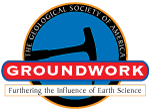Abstract View
Volume 27 Issue 8 (August 2017)
GSA Today
Article, pp. 28–29 | Full Text | PDF (268KB)
 |
| Search GoogleScholar Search GSA Today |
GROUNDWORK:
Earth-Science Outreach Using an Integrated Social Media Platform
1 The Institute of Geoscience Research, Curtin University, Perth, Australia
2 Chevron, Houston, Texas 77002, USA
3 Department of Geological Sciences, Stanford University, Stanford, California 94305, USA
4 School of Earth Sciences, Northern Arizona University, Flagstaff, Arizona 86011, USA
Introduction
Public outreach is an important aspect of every scientist’s job description, but, unfortunately, it is often the aspect that is most neglected. Barriers that prevent scientists from engaging in effective public outreach include the pressing demands of administrative responsibilities, a lack of training, misaligned incentives, and/or a lack of administrative support (Andrews et al., 2005). However, funding agencies still often require evidence for the broader impacts of research results for continued access to public funds. New approaches are needed that encourage participation, provide a greater return on time invested, and offer quantifiable metrics on their impact.
In response to these challenges, many people use the Internet to communicate science to a wider audience (Fig. 1). Web-based science outreach efforts often struggle without a focused goal and/or well-defined audience, or suffer from low visibility within a particular platform (e.g., blog, Facebook, Twitter). If one desires to have an impact on public discourse and opinion, it is essential to engage in multiple outlets, given the fractured and diverse nature of the information ecosystem (Bik et al., 2015; Bik and Goldstein, 2013). This means expanding beyond blogs and websites, and including social media sites like Twitter, Facebook, Instagram, and other digital media (e.g., viral videos, mobile apps, podcasts). When used effectively, social media engagement doesn’t replace scholarly output or “dumb down” science; rather, it boosts awareness, increases curiosity, builds community, and points readers to in-depth research of which they may not otherwise have been aware. In this article, we present a five-year multi-national case study using “TravelingGeologist” (TG), an integrated social media platform (ISMP) focused on inspiring new scientists using field-based research narratives. Garnering >50,000 followers across multiple web-based platforms and >100 contributors, we conclude that lessons learned from TG can help scientists broaden their impact and participation in outreach efforts.
Manuscript received 8 Feb. 2017; Manuscript accepted 24 Mar. 2017; Posted online: 3 May 2017
10.1130/GSATG333GW.1
©2017, The Geological Society of America.
